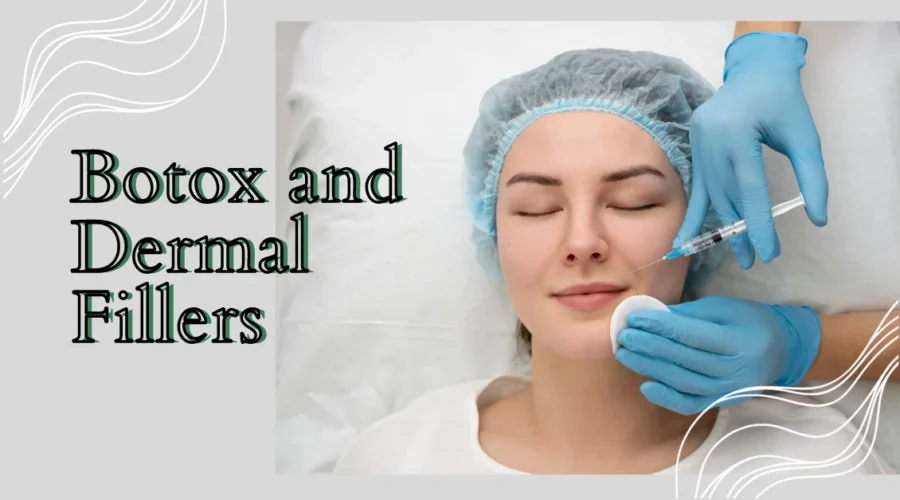Botox and Dermal Fillers: How They Work and Effects
Botox and dermal fillers are injectable cosmetic treatments aimed at reducing signs of aging. Botox, known as onabotulinumtoxinA, is a neurotoxin that relaxes targeted muscles to smooth out wrinkles, primarily in the upper face, eyes, and forehead. For instance, it’s often used to reduce crow’s feet and frown lines.
On the other hand, dermal fillers are substances injected under the skin to add fullness and lessen wrinkles, folds, and creases. A popular type, hyaluronic acid fillers, retains moisture, making fine lines less noticeable. Instance, it might be used around the mouth or on the jawline.
In this article, we will look into how these treatments work, and their uses and effects. So, without further waiting, let’s jump into the main discussion.
How Botox and Dermal Fillers Work
Botox works by temporarily paralyzing underlying facial muscles. When injected into specific areas such as forehead lines or crow’s feet, it blocks neurotransmitters that signal muscle contraction. The result is smoother skin with reduced lines and wrinkles.
Dermal fillers are designed to add volume. They work by filling in creases, lines, and hollow areas of the face caused by age-related loss of collagen and fat. Made from substances such as hyaluronic acid or calcium hydroxylapatite, these fillers are injected beneath the skin’s surface to restore fullness and smooth out wrinkles.
Fillers versus Botox
| Feature | Botox | Fillers |
| Target Areas | Lines caused by facial movements | Volume loss and facial folds |
| Reversibility | No (Needs natural degradation) | Yes (Using an enzyme) |
| Side Effects | Lesser | Possibly more |
| Lasting Effect | Shorter | Longer |
| Additional Uses | Preventative treatment for younger patients | Can help define facial features |
Botox and Dermal Fillers: Pros and Cons
Botox Pros and Cons
On the positive side, Botox is minimally invasive and requires no downtime. That makes it a convenient option for those with busy schedules. The treatment can provide instant results by relaxing facial muscles, resulting in smoother skin. Furthermore, it’s been proven that Botox works well for treating a number of medical issues like chronic migraines and excessive sweating.
However, Botox has disadvantages too, just like any medical therapy. The first concern is the temporary nature of the results. Typically Botox treatments last three to six months before requiring touch-ups. It adds some extra money to the treatment. Additionally, bruising or redness at the injection site are common discomfort individuals can experience. Even though they are typically mild and transient difficulties, they still need to be considered while choosing this therapy.
Dermal Fillers Pros and Cons
One of the major benefits of dermal fillers is their ability to restore lost volume and provide a more youthful appearance. They can effectively reduce the appearance of wrinkles, plump up thin lips, and smooth out deep facial lines. These fillers are made from various substances such as hyaluronic acid, collagen, or calcium hydroxylapatite, giving patients options that suit their specific needs.
However, dermal fillers come with some drawbacks that should also be considered. One potential disadvantage is the temporary nature of the effects. Most fillers last between six months to two years before requiring a touch-up or full repeat treatment. Moreover, injections of fillers may also cause adverse effects, including bruising, swelling, redness, or itching at the injection site.
Side Effects and Safety
Botox and dermal fillers have recently gained tremendous popularity as non-surgical cosmetic procedures. While these treatments offer impressive results, it is crucial to consider their potential side effects and ensure safety. From experiments and real-life applications, both treatments haven’t any crucial side effects. But it’s always better to maintain the safety guidelines to prevent any further discomfort.
Finding an experienced and qualified practitioner enhances safety during these treatments. Proper training ensures precise placement of both Botox and dermal fillers for successful outcomes while minimizing potential side effects. Along with that, understanding one’s own health history is essential in determining candidacy for such procedures. Conditions like pregnancy, breastfeeding, or allergies to any ingredients present in Botox should be discussed with a medical professional beforehand.
Remember that no matter how safe these treatments are deemed to be by professionals, it’s crucial to listen attentively. Always follow post-procedure instructions provided by your healthcare provider. Reporting any unusual symptoms experienced after receiving Botox or dermal filler injections will help further research on their long-term effects. That will ensure safer practices moving forward for all patients seeking these popular cosmetic procedures.
Wrap Up
Botox and dermal fillers are effective options for those looking to enhance their appearance and combat the signs of aging. Both treatments provide immediate results with minimal downtime. However, consult with a highly qualified professional who can educate and guarantee safe administration and successful results. It will make it easier for you to choose the therapy that is best for you.



